The ten oxherding pictures describe the Zen training path to enlightenment, Folk images are accompanied by poems and commentaries. They depict a young oxherder whose quest leads him to tame, train, and transform his heart and mind, a process that is represented by subduing the ox. Even though these images are presented in a sequence, Martine Batchelor cautions us against thinking that self-development and Zen practice go in a straight line; It is more like a spiral, and we go back to different stages but with more understanding. You can see these pictures adorning the walls of Zen temples in China, Korea, and Japan. The following commentary by Batchelor is adapted from her new book, Principles of Zen (Thorsons/HarperCollins). The short pieces at the beginning of each commentary are poetic verses by Master Kusan, first printed in his book The Way of Korean Zen. Master Kusan is the abbot of Songgwangsa Monastery near Kwangju City, Korea, illustrations are by Master Jikihara from the collection of Zen Mountain Monastery.
1. Searching for the Ox
High mountains, deep waters, and a dense jungle of grass—
However much you try, the way to proceed remains unclear!
To alleviate this sense of frustration, listen to the chirping of cicadas.
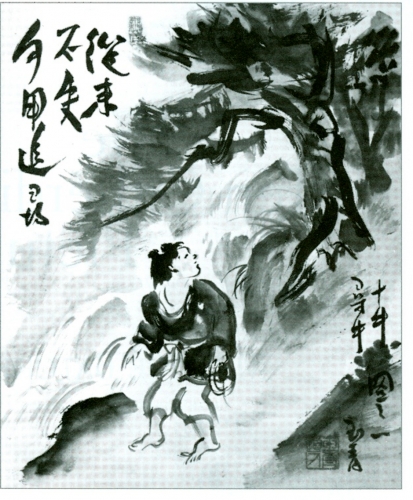
In this picture, the young oxherder is looking a little lost. He is searching for something, but he is not even sure what. This represents the stage when we have not started on the spiritual path yet, but we feel somewhat uncomfortable and unsatisfied. There are faint stirrings within us.
We think that if we had enough material things we would be happy. We would like to have a house with a nice garden or enough money to buy whatever takes our fancy. But nothing seems to completely satisfy us, to bring us that elusive long-lasting happiness.
Perhaps we hoped that a good relationship would give us lasting happiness, but it is very hard to find the right person or be the right person, all-loving, all-accepting. Even if we find someone, we discover that one person cannot satisfy all our needs, wishes, and hopes. A worthwhile or highly-paid job might give us security, but again this covers only a certain period of our lives. All these things give us only a fleeting happiness. Something seems to be missing. We are like the oxherder in the picture. There is a refreshing stream, beautiful trees, colorful butterflies, and wonderful birdsong, but still he is not satisfied. Like us, he is anxiously looking for something: inner peace, contentment, clarity.
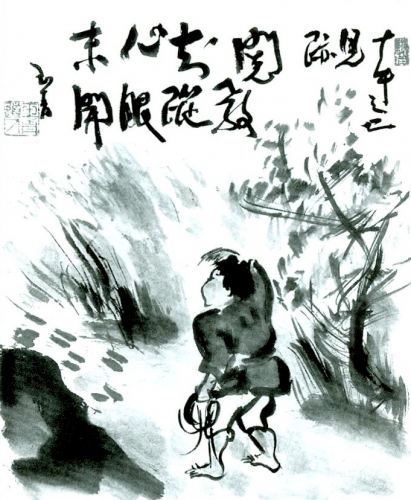
2. Seeing the Footprints
A tangle of thorny bushes: the faint murmur of running water.
But here and there are footprints—Is this the right path?
If you want to pierce its nose and tie it up, do not rely on someone else’s strength!
In this picture, the oxherder finally sees some footprints. It represents the stage when we decide to do something about the dissatisfaction. We look around for something. We discuss philosophy, read about psychology and various states of consciousness. We hear about meditation and Buddhism or Zen. We might have a friend who is practicing or we might listen to a talk by a Zen teacher. We like the idea of liberation and awakening or the quirkiness of the koan.
We are attracted to the Zen stories but we stop there. We just read about it. So, very little changes; we continue to have the same sufferings, the same disturbing emotions, and the same negative patterns. Reading or hearing about Zen only is not going to make a great difference in our lives. The other question this picture raises is: Are the footprints old or new? Is this Zen teaching and meditation relevant to us now or is it only for ancient Zen masters in China?
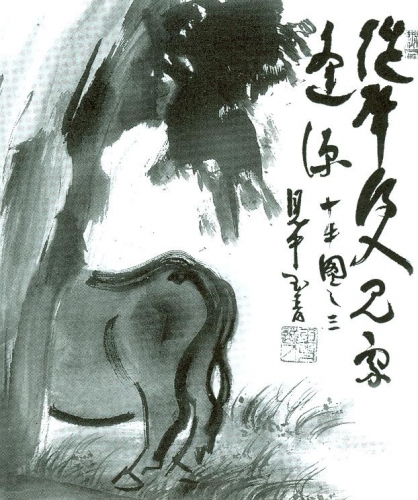
3. Seeing the Ox
Among willow branches swaying in the spring breeze an oriole is singing.
How can the sparrow experience his joy in calling to his mate?
Isn’t the moonlight glimmering in the forest my home?
Here, the oxherder finally sees the ox half-hidden among the trees. This image represents the stage where finally we decide to really do something. We are not totally sure yet what is the best method and what exactly we need to do. So we try various things. One week we visit a temple, another week we talk with a teacher. We continue to read books to find a good way to practice.
Finally, we might try meditation and as soon as we sit down for a while we experience some peace. We realize that this is something we can do ourselves and it is beneficial. We might also try to cultivate the precepts and be more harmless, generous, disciplined, honest, and clear. We see the point; we become familiar with the ideas not only at an intellectual level but also at an experiential level. We think that we have found something and we get very excited about it.
4. Catching the Ox
Advancing with difficulty; the ox’s nose is pierced.
But this fiery nature is hard to control.
Dragged here and there, you stray through cloud-covered forests.
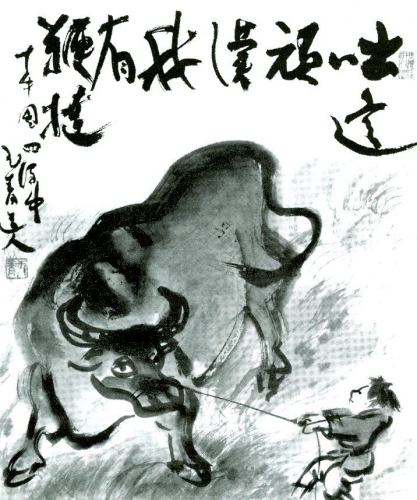
The oxherder has finally caught the ox with a rope. But the ox does not want to be caught. The oxherder holds on tightly as the ox jumps fiercely and drags him hither and thither. We feel very much like the oxherder when we start to meditate. We are given a set of instructions and think that following them should not be too difficult. Catching the ox was not hard but holding on to it requires much energy and strength. In the same way, sitting down with a method is the easy part, while applying the instructions for a certain period of time is what needs great determination and strength.
As soon as we sit down the mind is flooded with thoughts, memories, and plans, and our body is not comfortable. We start to have pain in the back, then in the knees, then our cheeks start itching. We try various postures. We want to forget about the past or the future but they come back all the more quickly. Like the oxherder we have to be firm and hold on tightly. There are many obstacles: restlessness, sleepiness, daydreaming, etc. We have to realize that for the last twenty, thirty years we have cultivated many habits which promoted distractions, and when we meditate we go against all these habits. It is going to take some time before we dissolve the power of these tendencies.
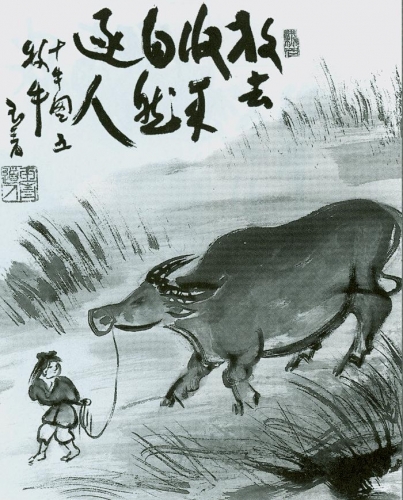
5. Tending the Ox
Fearing that it may fall into a steep and perilous path,
You hold it tight with whip and bridle, and with the strength of both legs firmly hold your ground.
Once past this critical moment, the ox comes following you.
In this picture, the oxherder is gently tending the ox and the ox is not wild anymore. They are walking alongside each other and the oxherder is holding the rope very loosely. After having held on tight and sustained the practice for a while, it becomes easier. We are more comfortable with the sitting posture. We can sit still without feeling restless. We are not fighting with our body and mind anymore. We can concentrate for a certain period of time. We have gained some quietness and clarity which helps us in our daily lives.
The oxherder still holds the rope loosely because he knows that although the fight is over, he must remain vigilant. The ox seems subdued but it could jump off at any moment. To practice Zen we have to be confident but aware of not becoming arrogant. We might feel that we know all about Zen but we still need determination and discipline as the powers of distractions are strong. This picture represents a stage of maturation and ripening accompanied by care.
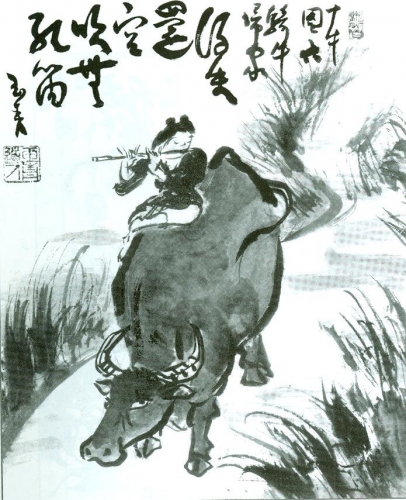
6. Riding the Ox Back Home
Sitting astride the ox, the noble person happily returns.
The sounds of his flute mingle with the crimson sky:
He has discovered the garden of joy.
Who else could know about this endlessly pleasurable taste?
The rope has gone. The oxherder is sitting leisurely on the ox playing the flute. The ox knows where to go without being told. This is an image of ease, leisure, and freedom. Some people believe that Zen is very strict and serious or that to be spiritual one has to be gloomy or indifferent. On the contrary, as we advance in the practice we find it is about joy and creativity. We begin to take ourselves less seriously and enjoy life so much more as we open to its changing and ever-fluctuating nature. We dance and sing with life. We have become friends with our body and mind.
This picture also shows us that there is a place for creativity in Zen. As we accept ourselves and the world, our potential unfolds, fears and insecurities dissolve; and we can express ourselves through music, painting, poetry, cooking, gardening, being with children or old people. Everything we do can become an art; it is not a duty anymore; it is a way to express our true nature.
7. Forgetting the Ox, the Oxherder Rests Alone
Bright Moon and cool wind: what a splendid home!
Sitting all alone, the ox has gone away.
Even if you doze until sunrise, what use would be a whip and bridle?
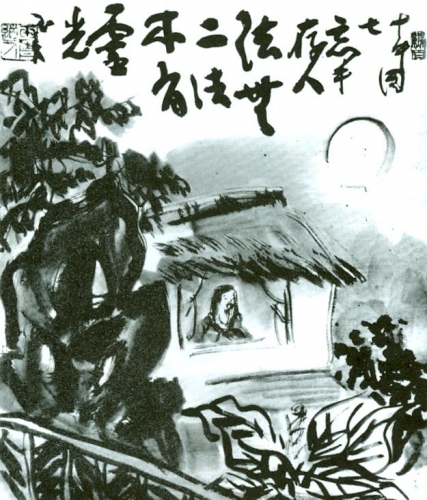
The ox has disappeared and the oxherder is resting alone at home. Until now there was this idea that there was something to do, something to practice. There was a separation between ourselves and the practice. There was a dualism between what was spiritual and not spiritual, what was Zen and what was not Zen. At this stage, we become united with the practice. It is not special anymore. It does not happen just when we sit on a cushion in a special room. Everything becomes meditation.
Awareness becomes as natural as breathing. We are at peace with ourselves, our mind, body, and heart, with th whole world. We do not even need to try to discipline ourselves, because now the practice and the cultivation of the precepts come unheeded. We do not have to do it; it does itself. As Master Kusan used to say: “You are one with the question. It is the question that walks, goes to the toilet, looks at the countryside.” Harmlessness and generosity come naturally. In this state, you cannot even think of being unkind or telling lies. Those kind of thoughts do not arise.
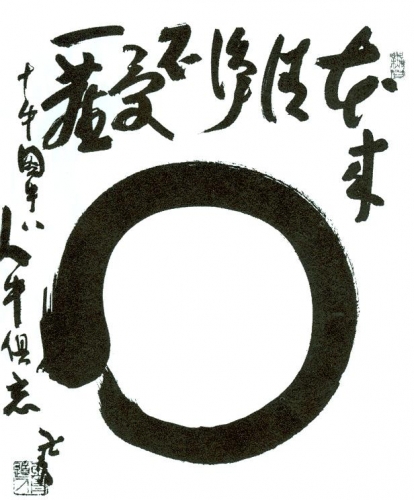
8. The Ox and the Oxherder Are Both Forgotten
Since space has collapsed, how can obstacles remain?
Could a snowflake survive inside a burning flame?
You cheerfully come and go: How could you not always laugh?
The oxherder and the ox are both gone. There is only a black circle. It represents emptiness. Earlier, when we became united with the practice, there was this idea that it is “me, I” that was practicing. Now this has gone too. We realize that nothing belongs to us truly; we can only care for it while it lasts. We also experience that we do not have a solid, separate identity. We are a flow of conditions. We are made up of all our genes, history, social conditioning, etc. Who are we but a bundle of aggregates and fluctuations? We cannot identify with our feelings, our thoughts, our possessions. They all come and go. They rise upon certain circumstances, stay a while, and disappear.
Everything is made up of conditions, which are ever-changing. There is nowhere to go, nothing to stick to. A great burden is let go of. We feel so light. We realize everything comes out of emptiness. Only because of emptiness can things change and flow. Emptiness is not a vacuum, a black hole, but the possibility of endless transformations. There is no more grasping, or self-created barriers and limitations. The Buddha-nature can shine through and express itself fully.
9. Returning to the Original Place
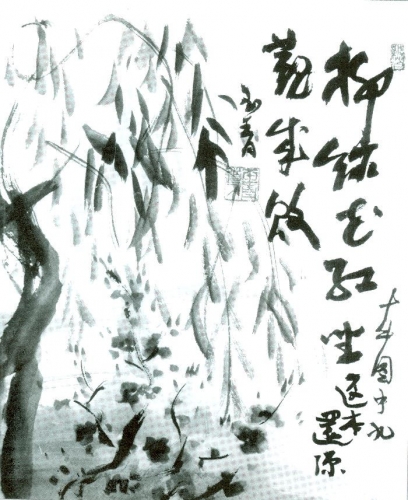
My very own treasure is recovered: all those efforts spent in vain!
It would have been better to be blind, deaf, and dumb.
The mountains and water are just as they are!
So is the bird among the flowers.
In this picture, water is flowing, flowers are blooming, and birds are singing. The practice does not stop at emptiness. If we attach ourselves to emptiness, it could lead to separation and isolation. So we have to go one stage further, reentering the world where “having forgotten ourselves, we are enlightened by all things.” We realize the interdependence which is at the root of all life. As we eat and chew a piece of toast we connect with the grain, the green shoots, the earth, the sun, the rain, and appreciate the efforts of all people who made that piece of toast possible. When we see a blade of grass swaying in the breeze, we are swaying with it.
Our life is ordinary and just as it is, but we look at it differently. We realize that everything expresses the truth of life and awareness, and is talking to us. We are not locked in on ourselves anymore but fully open to the world. We are not frightened but on the contrary exhilarated. The world is us and we are the world. All this practice—just to realize what was on our very doorsteps!
10. Entering the Marketplace with Helping Hands
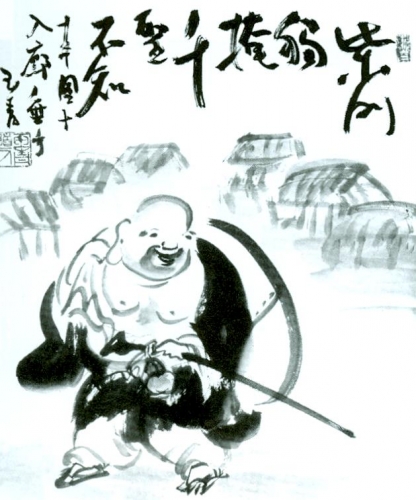
Ragged and bare-footed, you approach the market and the streets.
Even covered in dust, why would the laughter cease?
The bees and buttterflies are happy because flowers have bloomed on a withered tree.
This picture shows a ragged, potbellied man walking barefoot bearing a sack full of goodies. This last stage represents freedom, wisdom, and compassion. We are not encumbered by appearances. We adapt freely to high and low places. We find spirituality everywhere. Meditation and realization do not make us passive but active. We are deeply connected to the world; we feel its suffering and we want to respond and help. Our bag is full of joy, compassion, understanding, lovingkindness, wisdom, and skillful means.
We naturally give to ourselves and others what is beneficial. We listen deeply, we observe unobtrusively, and respond appropriately. When we give we do not expect anything. We are not superior to others when we help them; on the contrary, helping them is like helping ourselves and we are grateful they give us that opportunity. When we love, it is with total acceptance. We do not help only people we like and who are easy to be with but also people who are difficult and grumpy. However, we do not force our ideas—our opinions, what works for us—on others. We do not take it all so seriously.
We discover more ways to develop concentration and enquiry further. Master Kusan had three different major awakenings, and each time he continued to practice even more. The last time, his own teacher, Master Hyobong, said: “Until now you have been following me; now it is I who should follow you.”
♦
Continue exploring the ten oxherding pictures with Martine and Stephen Batchelor in Secular Dharma, a six-week online course which lays out a new vision for understanding and practicing dharma in the contemporary world.